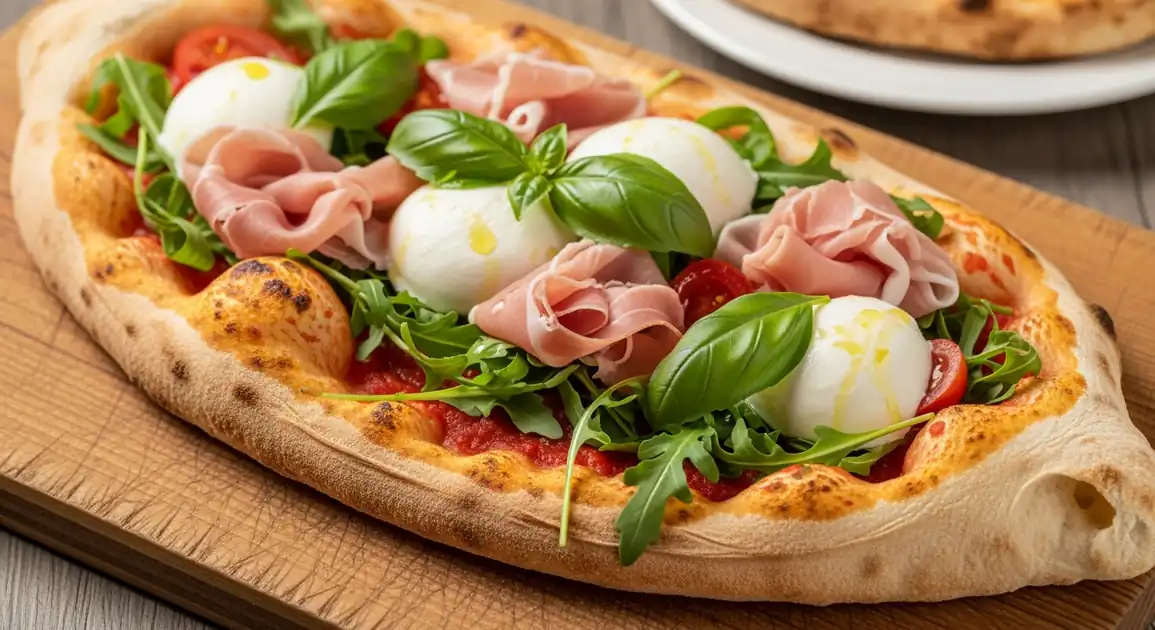Pinsa Romana (Roman Pinsa)
Pinsa Romana

Description
Rome is the birthplace and undisputed home of Pinsa Romana. It's ubiquitous throughout the city, served in countless dedicated 'Pinserie', pizzerias offering it alongside traditional 'tonda' (round pizza), and 'pizza al taglio' spots. Romans have embraced pinsa for its light texture and digestibility, making it a staple of the city's casual dining scene.
Dietary Information
Serving information
Serving style
Served hot. Whole pinsas typically on plates/boards eaten with knife and fork. Slices ('al taglio') on paper, often folded ('a portafoglio').
Quick facts
Lunch: 12 PM - 3 PM/3:30 PM. Dinner: 7 PM/7:30 PM - 11 PM/12 AM.
Safety Tips
What to Look For
-
Cooked fresh to order
Ensures the pinsa is hot, toppings are cooked correctly, and food hasn't been sitting out.
-
Served piping hot
High temperature cooking kills pathogens. The pinsa should arrive hot from the oven.
-
Reputable pinseria or restaurant
Established places with good reviews are more likely to maintain high hygiene standards and use quality ingredients.
-
Fresh-looking toppings
Ingredients like vegetables, cheese, and meats should appear fresh and appetizing.
-
Clean environment
Observe the cleanliness of the eating area, serving staff, and visible preparation areas.
What to avoid
-
Pre-topped or pre-cooked pinsas sitting out (uncommon for whole pinsas, might apply to some 'al taglio')
Food held at room temperature carries higher risks. Always prefer freshly baked.
-
Lukewarm pinsa
Indicates insufficient cooking or reheating, posing a safety risk.
-
Toppings that look old, wilted, or discolored
Suggests lack of freshness in ingredients.
-
Visibly unclean preparation areas or utensils
Increases the risk of cross-contamination.
Price information
Price range
Budget tips
- 'Pinsa al taglio' places offer good value, often priced by weight or slice (around 3-6 EUR per slice).
- Whole pinsas in pinserias range from 7-15 EUR depending on toppings and location.
- Neighborhood pinserias away from major tourist sites (like Colosseum, Vatican) might be slightly cheaper.
Value indicators
- Light, airy, bubbly crust with crispy exterior.
- High-quality toppings, especially Roman specialties (pecorino, guanciale, artichokes when in season).
- Served fresh and hot.
- Popularity with locals often signals good quality (e.g., Pinsere near Termini).
Where to Find This Dish
Trastevere
Many pinserias and restaurants offering pinsa in this popular neighborhood.
Piazza Trilussa, Santa Maria in Trastevere
Lunch, Dinner
Testaccio
Known for traditional Roman food, including excellent pinserias.
Testaccio Market, MACRO Testaccio
Lunch, Dinner
Prati
Area near the Vatican with numerous dining options, including popular pinserias.
Vatican Museums vicinity, Cola di Rienzo shopping street
Lunch, Dinner
Monti
Charming central neighborhood with good pinserias mixed among other eateries.
Via Urbana, Piazza della Madonna dei Monti
Lunch, Dinner
Near Termini Station
Home to the famous and highly-rated 'Pinsere' pinseria, known for quality and variety.
Termini Station, Via Flavia
Lunch
Vendor Tips
- Look for pinserias with a visible oven and dough preparation area.
- Don't miss trying toppings inspired by Roman pasta classics (Amatriciana, Cacio e Pepe).
- 'Pinsere' is consistently rated highly but expect queues during peak times.
- 'Al taglio' places allow trying multiple flavors in smaller portions.
How to Order
Regional Variations
-
Roman Classic Toppings
(Condimenti Classici Romani)
Strong prevalence of toppings featuring Pecorino Romano cheese, guanciale (cured pork jowl), artichokes ('carciofi' - seasonal), chicory ('cicoria'), and other local staples.
-
Pinsa 'Ripiena'
(Pinsa Ripiena)
Less common variation where the pinsa dough might be folded over a filling like a calzone, but with the characteristic pinsa dough.
Cultural context
History
While often marketed with nostalgic references to ancient Roman flatbreads, the modern Pinsa Romana is a relatively recent culinary innovation. Its specific formulation, utilizing a patented blend of flours (wheat, soy, rice) and techniques like high hydration and long cold fermentation, was developed around 2001 by the Di Marco company in Rome. The goal was to create a flatbread that was lighter, easier to digest, and recalled rustic, traditional bread-making methods. It quickly gained immense popularity in Rome and has since spread across Italy and internationally.
Local significance
A defining feature of modern Roman casual dining. Represents a successful blend of tradition (marketing) and innovation (technique).
Eating customs
- Using fork and knife for whole pinsas shows table manners.
- Folding 'al taglio' slices is practical for street eating.
- Often enjoyed with beer ('birra') or local wine ('vino della casa').